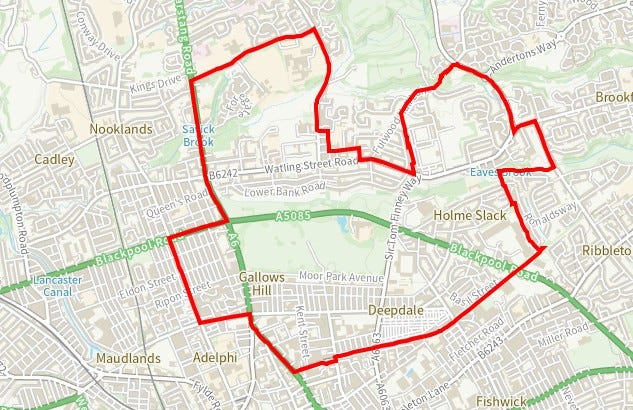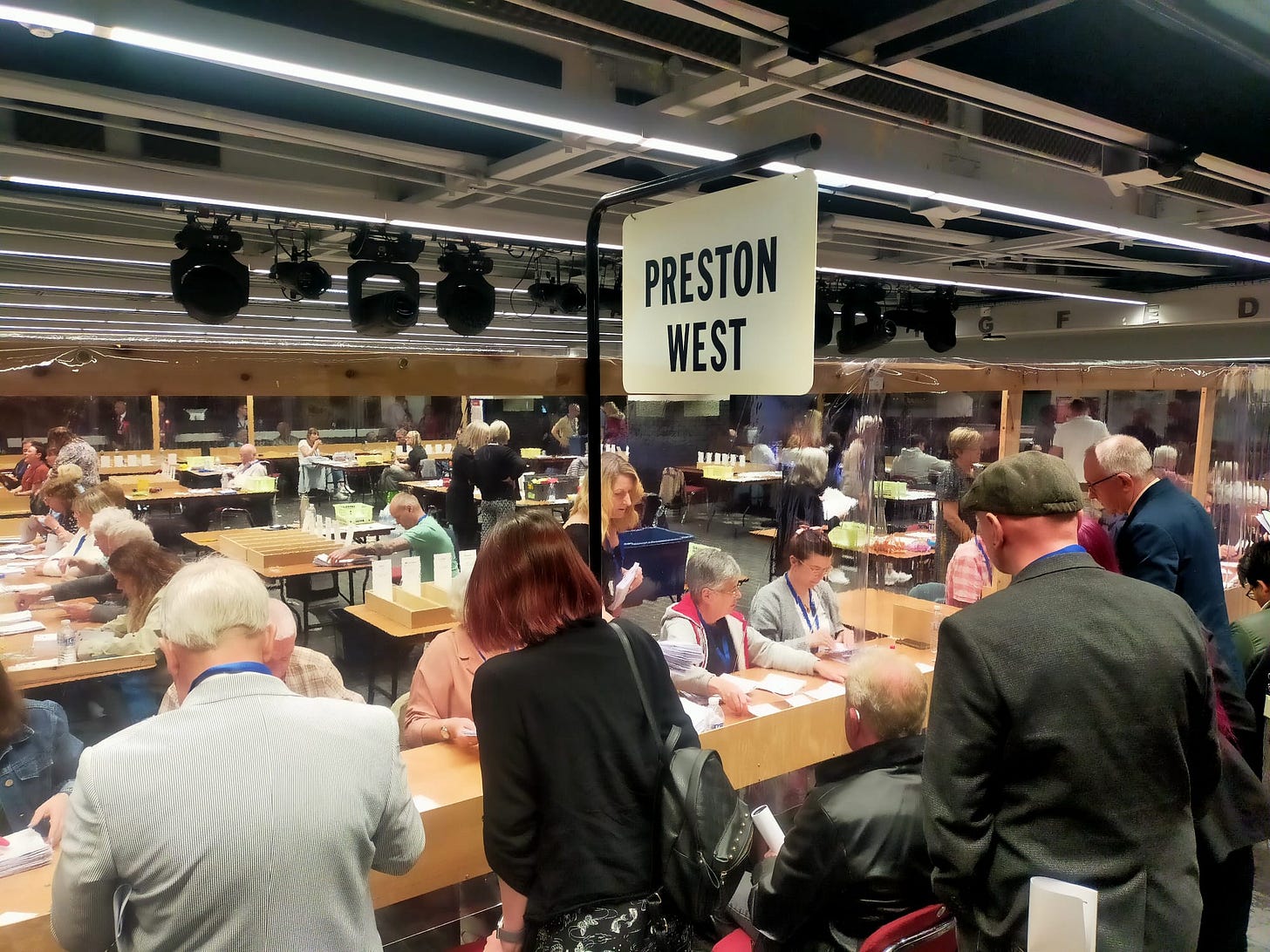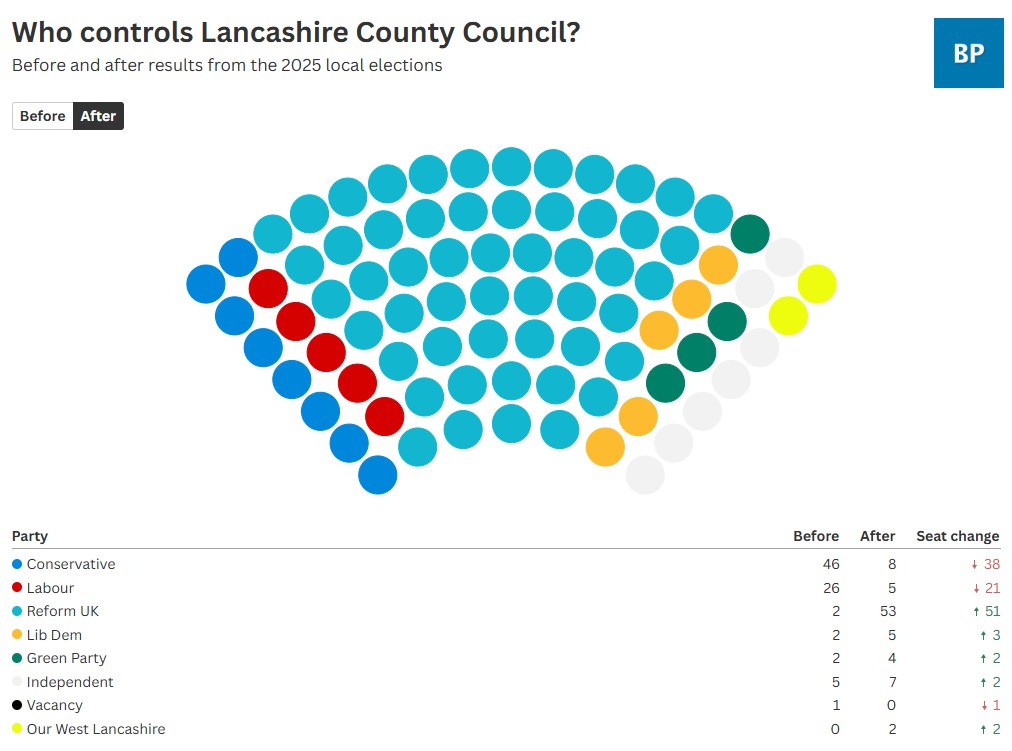Lessons from covering the local elections in 2025
As Lancashire turned Reform, what it's been like covering the local political scene in recent weeks
Good afternoon,
Something a bit different for the What I’ve Been Reading digest this afternoon, a learnings digest from the recent local elections which took place in Preston and Lancashire.
Thought I’d jot down some thoughts on how it played out and what we saw across Blog Preston and The Lead as the campaign progressed and the votes were cast.
The way Lancashire votes means there’s a two-tier set up, with a county council currently operating the likes of highways, education and social care across much of the county while districts, like Preston, empty your bins, take care of planning applications and plenty more. This is all due to change in the years ahead as the government steamroller on with local government reorganisation to introduce a unitary set up to Lancashire - building on the unitary authorities already operating for Blackpool and Blackburn with Darwen. There’s also the small matter of Devolution for Lancashire ongoing.
It was surprising these elections went ahead, given the backdrop of all that political jiggery-pokery going on, but the Conservative administration signed what turned out to be their own demise by saying they would go to the polls instead of delay the election for when a new set up was in place.
Let’s start with what happened pre-voting, as we decided to really double down on what we were doing on the local elections. We’ve always covered them on Blog Preston but primarily the district council election for Preston City Council, less so at the County Council level. But we’ve been seeing very strong engagement on anything LCC related, so we decided we’d position ourselves as a place to follow the county elections too.
Seat profiles: We attempted to do seat profiles for all the core patch seats within our area - these really got people talking as we asked the candidates to answer three straightforward questions.
Many candidates either didn't bother to respond (or in some cases didn't seem to exist!), or said they were 'too busy', others embraced the opportunity. Here's an example of one for Preston North.
I always think it’s a telling sign of how candidates respond when approached by a journalist offering them an opportunity to speak to people who might vote for them. All of these profiles scored very strongly in the SmartOcto CPI engagement index we used, suggesting people really did read and engage with them.
One crucial bit of information we included in these was where the hell the voting divisions actually covered. No one says they live in Preston Central West. It doesn’t exist! That informational-based content is crucial in an election.
Holding a hustings. We teamed up with National World, The Lead and the BBC Local Democracy Reporting Service to hold a well-attended and well-watched local elections hustings with the five major parties debating key topics for the county.
In a very sweaty room just under 100 people heard senior representatives - and the man who is now going to be the leader of Lancashire County Council - outline their views on key issues.
The live stream on Blog Preston’s account was watched nearly 20,000 times, and it’ll be many times more once you add in National World and The Lead’s social reach too. As always, it’s as much the voter at end of phone/keyboard/sofa who the politicians are talking to via a small screen as it is those in the room (who generally tend to be more partisan).
We’ve found holding events has been a very effective way of driving newsletter sign-ups (particularly for The Lancashire Lead as people discovered it for the first time) - it is part of the registration process. Yes, it’s time consuming, and there’s that nagging fear no one will turn up, but seeing Paul Faulkner give the candidates a good grilling is fast-becoming a Lancashire politics rite of passage.
Keeping a close eye on campaigning. We have been publicly criticised by Labour and Reform during the campaign, for reporting on claims made - particularly by Reform. Making politicians uncomfortable by asking questions is a basic principle of local journalism, yet one they certainly seem to struggle with grasping. We were the only local media outlet to challenge Reform on claims made/campaigning tactics - from concerns about fly-posting in a grade-II listed park, social media posts shared claiming a former care home would become an asylum seeker hotel and Preston’s ever-popular egg rolling being used as a place to canvas for votes.
We’ve been branded as ‘anti-Labour’ and ‘anti-Reform’. I tend to think that means we’re sitting somewhere in the middle when it comes to our coverage.
One thing I’ve noticed is the tendency from politicians to go in with both feet against individual journalists is increasing. It’s a worrying trend, and I hope those involved will reflect on as journalists we have to ask difficult questions - that’s our job. Although it’s worth noting all parties were keen to chat and do interviews at the count, so what people say on social media/emails v in real life is often different.
At the count..
Going live. For fast-moving situations like elections then the live blog format remains the best and most compelling way of keeping readers informed. We’ve used 24liveblog for a long while on Blog Preston now and it has good flexibility for use by updates on desktop and mobile (meaning you can walk the count chatting to people and add in updates direct from your phone).
Alongside being quick with the results as the divisions came in at the Preston count we also focused on ensuring there was context and chatter - giving depth and colour to our coverage beyond informational updates. This is important as there’s plenty of places to follow election updates but giving that feel and flavour of what was happening right there on the ground was our unique proposition.
Fusing together mine and Alice’s updates from Preston, Jamie Lopez being deep in the Ribble Valley (where he was one of the first to interview the Reform leader after their victory) and Paul Faulkner’s updates from the South Ribble count - along with Luke’s context from back at base gave a rich set of updates. And the 61,000 views it has seen suggests people agree - it’ll be one of the most viewed stories on Blog Preston in its 16 year history.
Being visual. As well as our written updates, election results are often about a change of control. This graphic Blog Preston’s co-editor and fellow Alma director Luke Beardsworth created via Flourish showed the change in seats in County Hall. It’s simple, but very effective.
Here’s Luke describing the reaction to it (the story it sat in about the overall election results has been viewed more than 20,000 times).
If you glanced at anything election related over the last fortnight, there's a good chance you saw this image. It captures the new make-up of Lancashire County Council - now led by Reform UK - and has been shared by Reform, Lib Dems, Greens and the OWLs (Our West Lancashire). It's been cropped slightly differently in each one.
I made this image to be prominent in our election coverage so I've been pleased to see it shared around so widely (and it's not a moan that nobody left the logo on or credited us, I left it completely open for anyone to use with their own coverage). I think it captures the sheer scale of the victory better than any 300 words we could write. To paraphrase one local politician when he was shown it at a count, it does boil the results down to an 'oh f***' core. Anyway, use Flourish. It's free and it's great.
Alongside graphics, we also tried to utilise video - whether that be the live stream from the hustings but also our YouTube interviews after the election results to try and give people the chance to hear direct from the politicians. As I wrote last week, we showed in the videos we were very much present at the count - which I think helps counter the rise of AI-generated content and gives our audience comfort that we’re there, asking questions and out there reporting.
Giving context. At every turn, we have always tried to give context, offer more than just X said Y coverage. Which I think is why we've taken such pelters from the politicians. But it is for our audience we report, not them. Here's my post-local elections opinion/analysis piece which has a SmartOcto engagement score of 924 out of 1,000 and has been read more than 5,000 times.
Context comes from contacts and relationships, we had a steady stream of people coming up to the press bench wanting to discuss stories/give their thoughts/wanting an interview. And as the final result was read out, during the pause before confirmation was given on winner and I hit 'publish' on the result the 'ding' of 24liveblog's sound rang out through the PA system because clearly the officer-core top table were following every word with us too.
The end result. On Friday 2 May, we saw 150,000 views on the site. I haven't totted up the social media views on top of that. But it will be the single largest audience day in our 16 year history. Well done to all of our team who have contributed to that in many different ways. I think it’s heartening when your top day is aligned with one of the core missions of setting up an independent news brand, to keep people informed on local matters and ensure they can engage in democracy.
There’s no magic formula for our election coverage, our audience from across all referrers was strong. If there was one thing to pull out, it was consistency and making the decision early that this was something we were going to cover with the focus and imagination needed to cut-through in what is a congested market as there’s no shortage of places to read about and follow elections and politics at national and local level.
Thanks for reading a different type of digest this week, I hope you’ve found it useful and if you’ve been covering the local elections then feel free to share thoughts, insights and tips in the comments.
The What I’ve Been Reading digest will be back with you in the usual format next Wednesday.
Have a great rest of the week. Keep going.
Ed





